《Artificial Intelligence:A Modern Approach》教学资源(PPT课件,英文版)Chapter 14-Bayesian networks
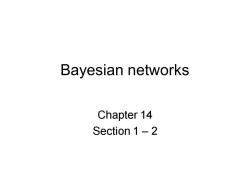
Bayesian networks Chapter 14 Section 1 -2
Bayesian networks Chapter 14 Section 1 – 2
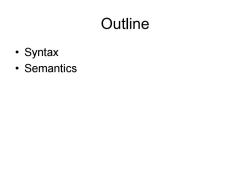
Outline 。 Syntax Semantics
Outline • Syntax • Semantics

Bayesian networks A simple,graphical notation for conditional independence assertions and hence for compact specification of full joint distributions ·Syntax: -a set of nodes,one per variable a directed,acyclic graph(link~"directly influences") a conditional distribution for each node given its parents: P(X|Parents(Xi)) In the simplest case,conditional distribution represented as a conditional probability table (CPT)giving the distribution over X;for each combination of parent values
Bayesian networks • A simple, graphical notation for conditional independence assertions and hence for compact specification of full joint distributions • Syntax: – a set of nodes, one per variable – – a directed, acyclic graph (link ≈ "directly influences") – a conditional distribution for each node given its parents: P (Xi | Parents (Xi )) • In the simplest case, conditional distribution represented as a conditional probability table (CPT) giving the distribution over Xi for each combination of parent values

Example Topology of network encodes conditional independence assertions: Weather Cavity Toothache Catch Weatheris independent of the other variables Toothache and Catch are conditionally independent given Cavity
Example • Topology of network encodes conditional independence assertions: • Weather is independent of the other variables • Toothache and Catch are conditionally independent given Cavity
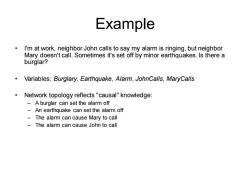
Example I'm at work,neighbor John calls to say my alarm is ringing,but neighbor Mary doesn't call.Sometimes it's set off by minor earthquakes.Is there a burglar? Variables:Burglary,Earthquake,Alarm,JohnCalls,MaryCalls Network topology reflects "causal"knowledge: A burglar can set the alarm off An earthquake can set the alarm off The alarm can cause Mary to call The alarm can cause John to call
Example • I'm at work, neighbor John calls to say my alarm is ringing, but neighbor Mary doesn't call. Sometimes it's set off by minor earthquakes. Is there a burglar? • Variables: Burglary, Earthquake, Alarm, JohnCalls, MaryCalls • Network topology reflects "causal" knowledge: – A burglar can set the alarm off – An earthquake can set the alarm off – The alarm can cause Mary to call – The alarm can cause John to call

Example contd. P(B) PE) Burglary 001 Earthquake 002 B E P(AIB,E) T T .95 T F .94 Alarm F T .29 F F .001 A P(JIA) A PMIA) JohnCalls T .90 MaryCalls T .70 .05 F .01
Example contd
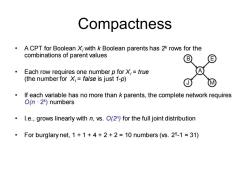
Compactness A CPT for Boolean X;with k Boolean parents has 2k rows for the combinations of parent values B Each row requires one number p for X;=true (the number for X;=false is just 1-p) M If each variable has no more than k parents,the complete network requires O(n·2 numbers .l.e.,grows linearly with n,vs.O(2)for the full joint distribution For burglary net,1+1+4+2+2=10 numbers (vs.25-1 =31)
Compactness • A CPT for Boolean Xi with k Boolean parents has 2 k rows for the combinations of parent values • Each row requires one number p for Xi = true (the number for Xi = false is just 1-p) • If each variable has no more than k parents, the complete network requires O(n ·2 k ) numbers • I.e., grows linearly with n, vs. O(2n ) for the full joint distribution • For burglary net, 1 + 1 + 4 + 2 + 2 = 10 numbers (vs. 25 -1 = 31)
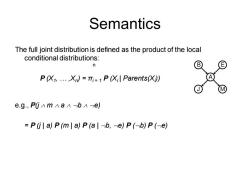
Semantics The full joint distribution is defined as the product of the local conditional distributions: n P(X1,..,Xn)=TTi=1P (Xil Parents(X)) e.g.,P(inmnan-bn-e) =P(jl a)P(m l a)P (al-b,-e)P(-b)P(-e)
Semantics The full joint distribution is defined as the product of the local conditional distributions: P (X1 , … ,Xn ) = πi = 1 P (Xi | Parents(Xi )) e.g., P(j m a b e) = P (j | a) P (m | a) P (a | b, e) P (b) P (e) n
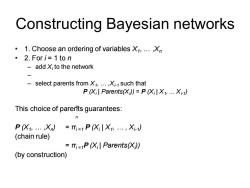
Constructing Bayesian networks 1.Choose an ordering of variables X1,...,Xn 2.For i=1 to n add X;to the network select parents from X1,...,X such that P(Xil Parents(X))=P(XilX1,...Xi-1) This choice of parerits guarantees: P (X1....Xn)=Ti=1P(XilX1:....Xi-1) (chain rule) =mi=P(Xil Parents(X》 (by construction)
Constructing Bayesian networks • 1. Choose an ordering of variables X1 , … ,Xn • 2. For i = 1 to n – add Xi to the network – – select parents from X1 , … ,Xi-1 such that P (Xi | Parents(Xi )) = P (Xi | X1 , ... Xi-1 ) This choice of parents guarantees: P (X1 , … ,Xn ) = πi =1 P (Xi | X1 , … , Xi-1 ) (chain rule) = πi =1P (Xi | Parents(Xi )) (by construction) n n

Example Suppose we choose the ordering M,J,A,B,E MaryCalls JohnCalls P(J M)=P(J)?
• Suppose we choose the ordering M, J, A, B, E • P(J | M) = P(J)? Example
按次数下载不扣除下载券;
注册用户24小时内重复下载只扣除一次;
顺序:VIP每日次数-->可用次数-->下载券;
- 《Artificial Intelligence:A Modern Approach》教学资源(PPT课件,英文版)Chapter 13-Uncertainty.ppt
- 《Artificial Intelligence:A Modern Approach》教学资源(PPT课件,英文版)Chapter 1-Introduction.ppt
- 《Artificial Intelligence:A Modern Approach》教学资源(讲义,英文版)chapter25.pdf
- 《Artificial Intelligence:A Modern Approach》教学资源(讲义,英文版)chapter25-6pp.pdf
- 《Artificial Intelligence:A Modern Approach》教学资源(讲义,英文版)chapter22.pdf
- 《Artificial Intelligence:A Modern Approach》教学资源(讲义,英文版)chapter22-6pp.pdf
- 《Artificial Intelligence:A Modern Approach》教学资源(讲义,英文版)chapter20b.pdf
- 《Artificial Intelligence:A Modern Approach》教学资源(讲义,英文版)chapter20b-6pp.pdf
- 《Artificial Intelligence:A Modern Approach》教学资源(讲义,英文版)chapter20a.pdf
- 《Artificial Intelligence:A Modern Approach》教学资源(讲义,英文版)chapter20a-6pp.pdf
- 《Artificial Intelligence:A Modern Approach》教学资源(讲义,英文版)chapter18.pdf
- 《Artificial Intelligence:A Modern Approach》教学资源(讲义,英文版)chapter18-6pp.pdf
- 《Artificial Intelligence:A Modern Approach》教学资源(讲义,英文版)chapter16.pdf
- 《Artificial Intelligence:A Modern Approach》教学资源(讲义,英文版)chapter16-6pp.pdf
- 《Artificial Intelligence:A Modern Approach》教学资源(讲义,英文版)chapter15b.pdf
- 《Artificial Intelligence:A Modern Approach》教学资源(讲义,英文版)chapter15b-6pp.pdf
- 《Artificial Intelligence:A Modern Approach》教学资源(讲义,英文版)chapter15a.pdf
- 《Artificial Intelligence:A Modern Approach》教学资源(讲义,英文版)chapter15a-6pp.pdf
- 《Artificial Intelligence:A Modern Approach》教学资源(讲义,英文版)chapter14b.pdf
- 《Artificial Intelligence:A Modern Approach》教学资源(讲义,英文版)chapter14b-6pp.pdf
- 《Artificial Intelligence:A Modern Approach》教学资源(PPT课件,英文版)Chapter 18-Learning from Observations.ppt
- 《Artificial Intelligence:A Modern Approach》教学资源(PPT课件,英文版)Chapter 2-Intelligent Agents.ppt
- 《Artificial Intelligence:A Modern Approach》教学资源(PPT课件,英文版)Chapter 3-Solving problems by searching.ppt
- 《Artificial Intelligence:A Modern Approach》教学资源(PPT课件,英文版)Chapter 4-Informed search algorithms.ppt
- 《Artificial Intelligence:A Modern Approach》教学资源(PPT课件,英文版)Chapter 5-Constraint Satisfaction Problems.ppt
- 《Artificial Intelligence:A Modern Approach》教学资源(PPT课件,英文版)Chapter 6-Adversarial Search.ppt
- 《Artificial Intelligence:A Modern Approach》教学资源(PPT课件,英文版)Chapter 7-Logical Agents.ppt
- 《Artificial Intelligence:A Modern Approach》教学资源(PPT课件,英文版)Chapter 8-First-Order Logic.ppt
- 《Artificial Intelligence:A Modern Approach》教学资源(PPT课件,英文版)Chapter 9-Inference in first-order logic.ppt
- 中国科学技术大学:《人工智能基础》课程教学资源(课件讲稿)Lecture 02 Intelligent Agents.pdf
- 中国科学技术大学:《人工智能基础》课程教学资源(课件讲稿)Lecture 03 Solving Problems by Searching.pdf
- 中国科学技术大学:《人工智能基础》课程教学资源(课件讲稿)Lecture 04 Informed Search.pdf
- 中国科学技术大学:《人工智能基础》课程教学资源(课件讲稿)Lecture 05 Constraint Satisfaction Problems.pdf
- 中国科学技术大学:《人工智能基础》课程教学资源(课件讲稿)Lecture 06 Game Playing.pdf
- 中国科学技术大学:《人工智能基础》课程教学资源(课件讲稿)Lecture 07 Logical Agents.pdf
- 中国科学技术大学:《人工智能基础》课程教学资源(课件讲稿)Lecture 10 Uncertainty and Bayesian Networks.pdf
- 中国科学技术大学:《人工智能基础》课程教学资源(课件讲稿)Lecture 11 马尔可夫决策过程.pdf
- 中国科学技术大学:《人工智能基础》课程教学资源(课件讲稿)Lecture 08 First-Order Logic and Inference in FOL.pdf
- 中国科学技术大学:《人工智能基础》课程教学资源(课件讲稿)Lecture 09 AI Planning.pdf
- 中国科学技术大学:《人工智能基础》课程教学资源(课件讲稿)Lecture 13 神经网络与深度学习.pdf
